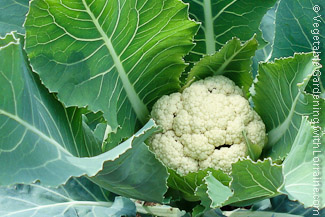- Home
- How to Grow Vegetables A-Z
- Growing Cauliflower
Growing Cauliflower
 Cauliflower Ready to Harvest
Cauliflower Ready to HarvestMany a gardener has found growing cauliflower to be challenging and frustrating, but it isn’t hard once you know the secrets of what makes cauliflower happy. It is one of the most persnickety and temperamental of vegetables, but if you give it what it needs it will feed you well.
Growing Cauliflower:
Making Cauliflower Happy
Soil
Cauliflower
needs very fertile soil, with plenty of nitrogen. You can do this by providing
your cauliflower bed with lots of high-nitrogen compost (well-rotted and made
with lots of coffee grounds or some manure) and giving it a
higher-nitrogen organic fertilizer once or twice during its life. It
likes a pH in the 6.5 to 6.8 range, but how many of us tweak our soil pH to
please a single crop? A ton of compost usually buffers things well enough to
make most plants happy.
Cauliflower seedlings are also sensitive to transplant shock, and appreciate a dilute dose of liquid fertilizer when transplanted. Compost tea, manure tea, or fish emulsion can all help.
Timing
It’s best to
start growing cauliflower indoors where it’s warmer, in seed flats under lights. I like
to use "deep-root" seed starting trays that have ridges inside to keep roots from circling. Plan it so that your transplant-out date is 2 or 3
weeks before your average last frost. Since your cauliflower seedlings should
be around 6 weeks old when you plant them out, that means to start them indoors
about 8 or 9 weeks before your last frost.
I start mine indoors, but plant them out when they’re only about 3 or 4 weeks old, because I put them under a temporary hoop tunnel which has warmed the soil and gives the seedlings some frost protection.
Consistency
Cauliflower likes consistent conditions. Like
the 3 Bears, Baby Cauliflower likes it “not too hot and not too cold” as well
as not too wet, not too dry, not too many bugs and not too cramped. The
seedlings like consistent, middle-of-the-road conditions. Don’t let them dry
out, get hot or cold, or grow spindly and root-bound in flats or 6 packs, or they’ll
decide not to make proper heads.
Protection from
Bugs
Cauliflower is susceptible to all the cabbage family bugaboos: cabbage
loopers, cabbage root maggot, imported cabbage moth/worm, aphids, and flea
beetles (when little). The absolute best way to protect them from any of these
is mechanical, not chemical: grow them under floating row covers such as
Reemay, which will prevent the bugs from getting to the plants. Other organic
pest control measures work too, but an ounce of prevention is worth a pound
of cure!
Cauliflower is also affected by some common plant diseases like clubroot and downy mildew.
Growing Cauliflower:
Blanching
“Blanching” in this case does not mean dipping in boiling water prior to freezing. It refers to the common practice of tying a cauliflower’s leaves up over the developing head to keep the sun off it so that it stays white. I’m not sure this is a nutritional improvement (chlorophyll is good for us, after all), but it is traditional, and we do seem to expect cauliflower to be white.
When the head starts to form and is about 2 or 3 inches across, tie the leaves up by loosely balling with cotton string. Leave plenty of room for the head to form, and make sure you check the plant frequently for the next several days. Most cauliflowers form a completely ripe head within about a week or ten days, and if you let it go too long it will start to get airy and spindly, and lose flavor.
After you harvest the cauliflower, the plant is finished, so pull it up and put it in the compost, with thanks.
Growing Cauliflower:
Conclusions
I think one of the reasons I love growing cauliflower so much is precisely because it is so finicky to grow. When I finally get a lovely cauliflower head, I feel like a proud parent, and enjoy every bite!
Blessings on your cauliflower crop, friends. Send me your success stories (or failure stories!) and photos, and I will post them here (on your very own page), where others can comment.
Help share the skills and spread the joy
of organic, nutrient-dense vegetable gardening, and please...
~ Like us on Facebook ~
Thank you... and have fun in your garden!
Affiliate Disclaimer
This website contains affiliate links to a few quality products I can genuinely recommend. I am here to serve you, not to sell you, and I do not write reviews for income or recommend anything I would not use myself. If you make a purchase using an affiliate link here, I may earn a commission but this will not affect your price. My participation in these programs allows me to earn money that helps support this site. If you have comments, questions or concerns about the affiliate or advertising programs, please Contact Me.Contact Us Page




